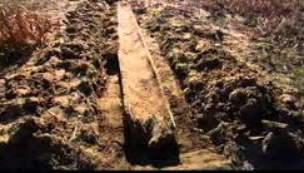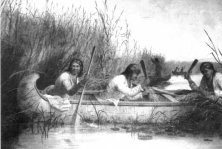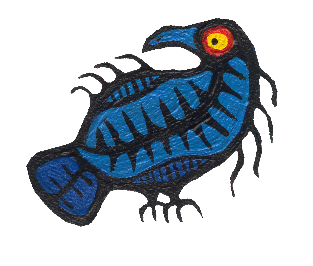Native-Art-in-Canada has affiliate relationships with some businesses and may receive a commission if readers choose to make a purchase.
- Home
- Indian Canoes Overview
Indian Canoes
Dug Out to Birchbark
 5000 year old Dugout Canoe
5000 year old Dugout CanoeNo one knows how or when Indian canoes were first made. There were no written records and,of course, wood, bark and hide disintegrate rather quickly so clues aren't around to tell the tale.
But, just a few years ago, some high school students working on an environmental project along the shores of Florida's Lake Newnan, came across the remains of 85 prehistoric dugout canoes! The log canoes had remained hidden and preserved at the bottom of the lake all this time, but during a dry spell the water level in the lake dropped and they became visible.
Using radiocarbon testing, archaeologists have confirmed that those Indian canoes ranged from 500 to 5000 years old with most built between 3000 and 5000 years ago.
The dugout canoes were be up to 22 feet long. Many had rounded sterns and bows (as opposed to a flat end). The dug out canoes had been made by burning a hollow in a large log and removing the burnt remains with a stone or bone scraper.
Tests on six canoes showed they were made of pine but it wasn't possible to test them all. The scientists had worked quickly to document the find and then the Indian canoes were re-buried in the mud at the bottom of the lake. If they had been left out in the air and sun, they would have crumbled in a matter of days.
Here's a link to the Lake Newnan canoe site.
Indian Canoes in the Eastern Woodland Culture
According to records written in the middle of the 16th century by European settlers in an area that is now known as North Carolina, cedar was the tree of choice for Indian canoes. Cedar is relatively light and remarkably resistant to rot. But canoe builders often had to use what was available, and sometimes that was pine, poplar, black walnut or whatever. There is a single example of a 2500 year old dugout canoe in a museum in Raleigh, North Carolina.
Dugout canoes are by nature unstable. The rounded bottom makes for a real life 'tippecanoe' and the shallow draft of the floating log wouldn't make for a steady ride.
Not all Indian canoes were dugouts. Some canoes were made from hides stretched over a frame. Beothuk people of Newfoundland made boats in this manner. They stretched rawhides over a frame of lashed saplings and sealed the joints with a mixture of spruce pitch and animal fat. The Beothuk boats tended to be round and must have been very difficult to paddle. The Beothuk people...men, women and children...were systematically hunted and killed by European fishermen tight into the early years of the 19th century. No examples of their little boats remain.

In my part of the world the Anishnabe had perfected the birch bark canoe long before I was born. The grainy photo on the right was first published in Scribners magazine in 1895. My grandparents were the last people that I personally knew who were making birch bark canoes as late as the 1930's and 40's. But I've since come across a handful of people who are still building with birch bark...more about them later.

- Indian Canoes...A brief overview
- Birchbark canoes...how to build one.
- How to Build Birchbark Canoes These step by step instructions will give you a general idea of what is involved in building a birchbark canoe.
- How to fell a tree without an axe Just in case you forgot your axe...here's plan B
- Home





